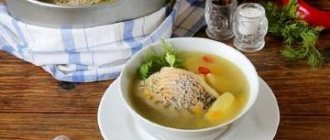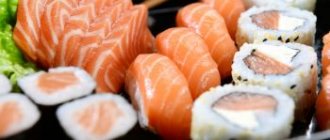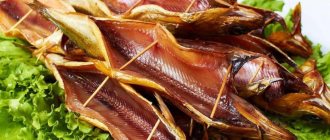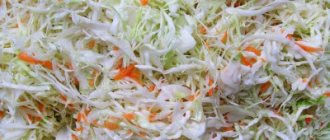Edited by an expert:
Nadezhda Primochkina, nutritionist - 11/03/2020
Fish is a healthy protein product that can rarely provoke allergic reactions . At the same time, fish often causes pseudo-allergic manifestations. This means that after eating a significant amount of fish, a person is bothered by the symptoms of common allergies - rashes, itching, redness, but they are not caused by disturbances in the functioning of the immune system, but by excessive consumption of a product rich in histamine.
The benefits and harms of fish
ads
In terms of nutritional value, fish can be compared to meat, but it is more easily absorbed by the body. The product contains a number of vitamins that are beneficial for the baby: B vitamins, vitamin A and D. In addition, it contains other useful substances: phosphorus, potassium, magnesium, calcium, iron, fluorine, sodium. The iodine contained in the product has a beneficial effect on the development of mental abilities and the functioning of the thyroid gland, muscle and nervous systems. That is why it is very important for children under one year of age to receive fish along with other complementary foods.
Every mother needs to remember that certain foods that are well tolerated by the adult body can be harmful to the health of the child. This applies in particular to fish. Nutritionists have conventionally divided all fish into 3 groups: low-fat (skinny), medium-fat and fatty. According to this classification, this or that fish is introduced into baby food from a certain age. See the table below for detailed information.
| Group of fish | Name | Product fat content | When is it recommended to introduce it into a child's diet? |
| Low-fat (lean) | Hake, haddock, flounder, river perch, pollock, navaga, cod | Up to 4% | At 9-11 months |
| Medium fat | Pink salmon, sturgeon, chum salmon, trout, sea bass, herring, sea crucian | 4-8% | At 1.5-2 years |
| Fat | Mackerel, eel, salmon, omul, herring | Above 8% | At 3-4 years old |
Although fish is usually well tolerated by young children, allergic reactions occur in rare cases. Particularly dangerous are immediate allergic reactions that can cause suffocation. Therefore, when introducing fish complementary foods, it is necessary to especially carefully monitor the baby’s condition.
Fish in children's diet. What kind of fish can children eat?
There is one special category of parents: their children eat fish. Answering everyone else, including me, to the question: “How do you do it?”, some shrug their shoulders in bewilderment: “We didn’t do anything special, we just love fish very much. We lived in Vladivostok as children, fish and seafood were constantly present on our table, and fishing was our favorite pastime,” others say much the same: “In our family, we all, including children, eat fish because we like it.” like". I would add to this the ability to choose and properly prepare this delicate product.
Useful properties of fish
- Fish is a source of complete proteins and essential (not synthesized in the body) amino acids; it contains the same amount of them per unit weight as lean meat.
- White fish contains small amounts of fat, while the fat in other types of fish (salmon, mackerel, herring, sardines) contains omega-3 polyunsaturated fatty acids, which are important for the development of the nervous system and are beneficial for the heart and blood vessels.
- Sea and freshwater fish are a valuable source of microelements: iron, zinc and selenium, which, although present in smaller quantities than in meat, are just as well absorbed.
- Sea fish is the main source of iodine, which accumulates in it from the marine environment. This is important because almost all regions of Russia have mild or moderate iodine deficiency.
How to choose fish? The fish must be absolutely fresh, this is the main condition. Buy fish where it is properly stored and sold quickly. If, approaching the fish department, you smell a specific smell, do not even approach it. When you buy fresh fish, ask the seller to peel back the gills and smell: no fishy smell, just a slight aroma of sea water.
Signs of fresh fish:
- clear eyes,
- dense, shiny scales,
- natural color and moisture,
- elasticity to the touch,
- a subtle smell of the ocean instead of a persistent fishy stench.
The myth about fresh frozen fish For some reason, buyers are prejudiced against fresh frozen fish, considering it a less valuable product than chilled fish. However, the peculiarities of fishing are often such that the caught fish is cut up, immediately frozen and put on the shelves in this form. Proper freezing does not change its beneficial properties at all, and the ice glaze, which is present in minimal quantities from a conscientious manufacturer, protects the fish from oxidation and drying out.
Such fish should be defrosted slowly, on the refrigerator shelf at the lowest temperature: this is safe and allows you to preserve its texture and taste. Of course, fish should only be frozen and thawed once.
The World Wildlife Fund (WWF), an independent international environmental organization, has issued a special guide for fish consumers in Russia, which introduces all interested parties to the peculiarities of catching (or growing) fish and seafood and gives recommendations to buyers. This .
What kind of fish can children eat and how should they cook it? Tips with examples Children usually have two complaints about fish – the bones and the actual fishy taste. Therefore, you need to choose the least bony fish and try to remove all the small bones using special tweezers. Another option is to make fish cutlets or meatballs. If you are preparing them from lean fish, be sure to add a little butter to the minced meat. Something as simple as adding a teaspoon of sugar per pound of minced fish will also enrich the taste of the cutlets. This technique is used by manufacturers of canned fish for baby food.
As for the taste of fish fillets, in addition to the impeccable freshness of the fish itself, marinades can help. If you bake the whole fish, add herbs and lemon slices to the belly. When using fillet, you can rub it with a marinade of olive oil, garlic, lemon juice and add slightly mild mustard (for a child over three years old) and honey (or sugar). Variations are possible - instead of lemon juice and mustard, use a little soy sauce. Or the simplest option: salt, a little ground pepper, olive oil, fresh thyme.
It is very important that the fish is fully cooked, but in no case is it too dry: then it is simply inedible. I have an old edition of “Baby Nutrition” from 1957 - “a book on how to properly feed a child in order to raise him healthy and strong.” This guide recommends simmering the fish pieces in water at a low simmer for 30 minutes. It seems to me that this is too long, and besides, boiled fish is an amateur dish, but baked or grilled fish will probably be a success. If a child likes pasta (I haven’t come across children who don’t like it) with white sauce, it’s quite possible to add small pieces of fish fillet to it.
What fish dishes and products are best avoided?
- Up to three (and preferably up to seven) years of age, children should not be offered strong fish broths and soups, fish jellied fish, caviar, beloved by grandmothers, is also prohibited: due to the very high fat content, salinity and the presence of preservatives, caviar is not a children's product.
- You should not offer children dried and smoked fish.
- Surrogates like crab sticks have no place in baby food either.
- If your child's mom, dad, or other blood relatives have a proven allergy to any type of fish, shellfish, or crustaceans, you should consult your doctor before giving your child any of the above.
- The key to fish consumption is moderation (1-2 times a week, as much as your child will eat) and variety. Pollution of the World Ocean due to human activities and modern aquaculture technologies force us to be more careful in choosing the fish we eat.
Which fish is the healthiest?
For children, sea fish is considered the most beneficial, since it contains valuable vitamins and minerals that contribute to the correct and complete development and functioning of the body’s most important systems - circulatory, nervous, protective and endocrine. Omega-3 fatty acids contained in sea fish are important for the brain, the formation of a stable immune system, and for fighting inflammation.
If we talk about which fish is the healthiest for infants, then in this case pediatricians and nutritionists definitely recommend low-fat sea varieties - hake, cod, flounder, navaga or pike perch. In the first month of complementary feeding, offer your baby one type of fish and only then move on to the rest.
White sea fish is considered environmentally friendly, unlike river fish. In addition, river species are more often infected with parasites. Sea varieties are good because they have practically no bones, and those that do exist are easily separated from the fillet. This product can be used to make fish puree, meatballs or cutlets. Of the freshwater species, the best option for a little gourmet would be trout.
Useful properties of seafood
In many countries, so-called non-fish seafood are considered both a delicacy and a cure for aging: shrimp, crabs, squid, octopus, sea cucumbers, cucumaria, sea urchins, scallops, mussels...
Their advantages are considered to be a high content of proteins and biologically active substances, low calorie content and an almost complete absence of fat. Squid, shrimp and crab are 73-82% water and 18-23% complete proteins. 100 g of these products contain about 100 kcal, plus vitamins and minerals. Squid has a lot of potassium, shrimp has calcium, crab has phosphorus and iron.
What are the beneficial properties of seafood? Doctors recommend these seafood for loss of strength and anemia. True, they still need to be cooked correctly. Shrimp and crab meat are often sold already cooked and frozen. In this case, it is enough to simply heat them up, but in children's dishes it is better to bring them to a boil. You can also find delicious recipes for salads with shrimp or crabs - this way, along with the beneficial substances of seafood, you will also get vitamins and minerals contained in other salad ingredients. But the squid, so that it remains soft, is fried for several minutes over high heat, or chopped and stewed for about forty minutes, maybe with sour cream.
A lot of vitamin A is found in the liver of cod and pollock, even canned fish. Red caviar consists of one third of protein and 12% of easily digestible fats. It is also rich in vitamins A, D, E, group B, lecithin, phosphorus, and iron. However, these products can only be given to children after 5 years of age and in small quantities.
Laminaria (sea kale) stands somewhat apart from other seafood. It, of course, could be classified as a vegetable group, but it still grows in the sea. It is very low in calories, almost without fat and protein. But it contains almost 30 thousand times more iodine than sea water, 500 times more phosphorus, 400 times more iron and 300 times more copper. Kelp is also rich in vitamins A, D, B1, B12, and ascorbic acid. Dried kelp contains from 15 to 20% of unique alginic acid, which cleanses the body by removing heavy metals, cholesterol, radionuclides and other toxins. It is recommended for anemia, constipation, obesity and other pathologies. It is necessary to regularly include seaweed in a child’s diet if the child is lagging behind in physical and mental development, as well as with insufficient thyroid function.
Some seafood for children can cause allergic reactions, so be careful. It is better to introduce them into the diet after three years. Nevertheless, the gifts of the ocean are one of the most useful products. It is not for nothing that the Japanese, the healthiest nation in the world, consume 20 times more meat than Russians, but 10 times less meat.
At what age can fish supplements be given?
A healthy baby can try fish complementary foods at about 9-10 months. Doctors recommend introducing the product about a month after receiving meat complementary foods. If the baby has allergies, then it is better to start introducing fish dishes after a year, with extreme caution.
Start with low-fat varieties - hake, pollock, cod, etc. It’s great if the complementary feeding product is prepared at home. For the first time, ¼ teaspoon of fish puree will be enough for your baby. To monitor your baby’s condition, introduce new complementary foods into one of the morning feedings. Allergic reactions usually appear after several hours.
After a year, babies are recommended to eat fish dishes 2-3 times a week. Offer red fish, as well as fatty varieties, to your child no earlier than 2 years old. Lightly salted herring is allowed to be given to children from the age of three in small quantities. Canned fish (sprats), caviar and smoked fish products are not recommended for children under 6 years of age.
Fish purees from the manufacturer
It is difficult to buy one-component puree for the first complementary feeding, either it simply does not exist, or very little of it is produced. But the assortment includes enough fish and vegetables. This type of puree is available in many brands.
But not all brands indicate what kind of fish was used in preparation, which is very inconvenient - after all, if a child has an allergic reaction, it will be impossible to determine why it happened. You will have to exclude all fish from the baby’s diet.
When buying ready-made puree, pay attention to its composition, in addition to fish and vegetables, it may contain spices, oils, milk powder, flour or starch. If something confuses you about the composition of one puree, choose another brand.
How to choose fresh fish?
The most common question you hear in fish departments is: what kind of fish for children is not bony? This, of course, is also important. But when buying fish for your baby, first of all, pay attention to its freshness. This can be determined by its bright red gills, convex and light eyes, and smooth and shiny scales.
The questionable quality of the product will be indicated by mucus under the gill covers, the presence of a film on the eyes, faded or peeled scales in places, and a swollen abdomen.
If you buy frozen fish, try tapping it. A high-quality frozen product will produce a ringing sound. As for the less bony varieties, this list includes almost all sea varieties and trout.
Which one should you give up?
The first and important criterion for refusing a particular fish is its high fat content. Despite its rich taste, softness and the presence of Omega-3 fatty acids in high concentrations, it is not recommended for children under three years of age to eat it.
Oily fish include:
After three years, this fish can benefit the body, however, it is recommended to consume it no more than once a week, boiled or baked in its own juice.
Another criterion forbidden for children is an artificial habitat. In addition to the fact that artificial reservoirs are considered one of the most polluted habitats, their nutrition and hormones negatively affect not only children, but also adults.
List of prohibited products for children of all ages.
- Salmon and trout are fed with feed containing a special dye called canthaxanthin, which gives the fish a marketable bright red hue. Regular consumption of products with such additives causes vision impairment.
- Solefish or pangasius is bred in Southeast Asia in the Mekong River, considered the most polluted in the world.
- Tilapia is massively processed with male hormones, and is also an omnivorous species, carrying many intestinal infections and pathogens.
It should be noted that food for fish grown artificially does not have strict requirements, and therefore unscrupulous sellers actively use low-quality food, flavored with antibiotics and other chemical compounds. Regularly consuming such varieties and offering them to children can significantly suppress natural immunity.
How to cook better
ads
Now let's talk about the rules for preparing fish dishes and find out the best recipes. To make fish dishes healthy and tasty, follow these rules:
- For baby feeding, choose the most delicate varieties. To prevent your child from developing an aversion to the healthy product, treat the fillet with lemon juice before cooking. After half an hour, rinse with water. This will soften the brightness of the sea aroma and taste.
- Make sure there are no bones in the finished dish. If a child chokes, it will frighten him and may harm his health.
- For children's menus, it is preferable to prepare steamed fish dishes. They are more gentle and healthy.
- When cooking, it is recommended to lower the product into boiling water and immediately reduce the heat. Fish boiled in large pieces or whole is much tastier and juicier.
- Adding carrots, broccoli or zucchini to the water where the product is cooked will help improve the taste of fish dishes.
- Delicious dishes are obtained from fish baked in foil or heat-resistant dishes. Vegetables, herbs, and sauces are usually added to these dishes.
Pike perch in camouflage
Among fish dishes for children, casseroles are almost always a hit. Boil 300 g of pike perch fillet for 7–8 minutes from the moment of boiling. Dry in a frying pan without oil 1 tbsp. l. flour, mix it with 1 tsp. butter and pour in ½ cup of warm milk. Lightly salt the mixture and, stirring constantly, bring to a boil. At the end, whisk it with the egg. Knead the boiled fillet with a fork, put it in a greased form, put potatoes (2-3 tubers) cut into circles on top, and pour milk sauce over it. Sprinkle cheese on top of the fish and place in an oven preheated to 180°C for 20–25 minutes. This casserole makes a great dinner, especially when paired with fresh vegetables.
We prepare delicious and healthy fish dishes for your baby
Fish puree
- fish fillet without skin – 60 g;
- vegetable oil and milk - 5 ml each.
Preparation:
- Boil the fillet in a small amount of water for 15 minutes.
- Mash the cooled fillet with a fork or beat with a blender, first removing the bones.
- Add milk and butter to the mixture. Add salt.
- Stir and simmer over low heat for 1 minute.
- Serve warm.
Fish meatballs
- fish fillet – 60 g;
- wheat loaf (roll) – 10 g;
- yolk – ¼ pcs.;
- water – 1 tbsp. spoon;
- vegetable oil – 4 ml.
Preparation:
- Make minced meat from boneless fish fillet and pre-soaked bread
- Add yolk, butter, mix well.
- Form small balls from the resulting mass.
- Place the meatballs in a bowl and fill them halfway with water.
- Place on low heat for 25-30 minutes.
Fish pudding
- Fish fillet – 100 g;
- potatoes – 1 pc. (50 g);
- oil – 0.5 tbsp. spoons;
- egg – ¼ pcs.;
- milk – 30 ml.
Preparation:
- Boil the peeled potatoes.
- Drain the water and make mashed potatoes. Add milk.
- Boil boneless fish fillets in lightly salted water.
- Chop the pulp, add puree and melted butter - 1 teaspoon. Add the beaten egg. Add salt.
- Place the prepared mixture into a greased form and cover with a lid.
- Cook the pudding in a water bath for 25-30 minutes.
- Cool.
Cooking fish for a child
The fish needs to be washed and all the bones removed. If this is a problem for you, then take varieties that do not contain small bones: flounder, hake and blue whiting.
Boil the fish for 20 minutes over medium heat; as soon as it becomes soft, check the piece again for the absence of bones and grind it through a sieve or in a blender. Do not add any spices, you can add a little salt and dilute the mass with breast milk.
For children who already chew well, you can give steamed fish by simply mashing it with a fork. As soon as the baby gets used to the new taste, start preparing fish dishes. These can be casseroles, fish souffle or cutlets.
The child’s taste preferences also change and this is normal, so if your child refuses fish, do not insist. Over time, fish may become his favorite food. But he is unlikely to like imposed dishes. Therefore, patience and respect for the baby’s preferences.
Subtleties of cooking fish
- When cooking frozen fish, you can defrost it in salted water, this will prevent the mineral components from being lost.
- A steamed dish will retain more nutrients.
- Dip pieces of fish only into boiling water, this will make them tastier.
- Take a small amount of water for cooking.











